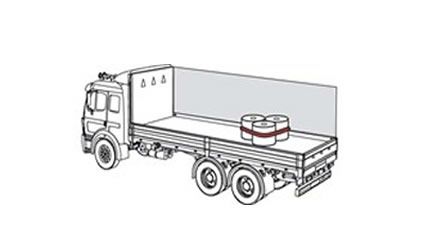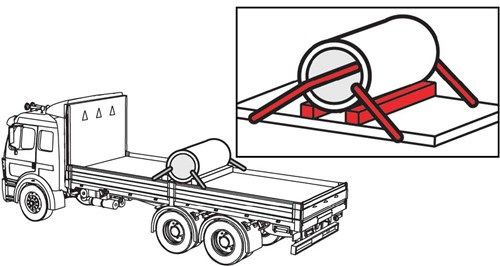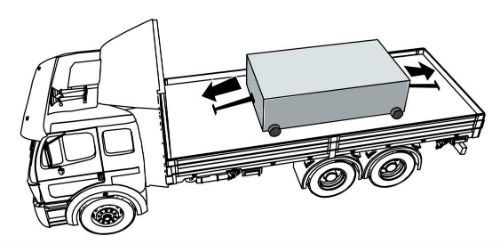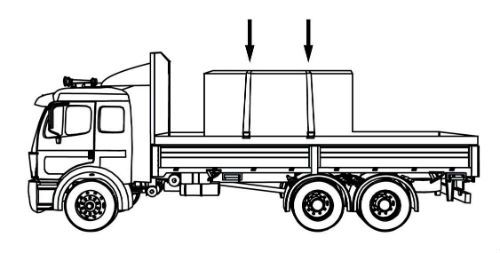CDL Practice Tests: Flatbed Cargo Securement
Choose A Section:
Go!Specific cargo securement rules on automobiles and light trucks apply to vehicles of what weight?
- 4,500 lbs or less
- 10,000 lbs or less
- It depends on what the vehicle is used for.
- 12,000 lbs or less
What Does This Section Cover?
The requirements in this section apply to the transportation of automobiles, light trucks, and vans that individually weigh 4500 kg (10,000 lb.) or less.
Methods of securing building materials against forward motion include:
- Using tiedowns.
- Placing bundles against the bulkhead or front end.
- Employing blocking equipment.
- These are all valid methods.

-
Option #1
Place bundles against bulkhead/front end structure.
-
Option #2
When different tiers need to be secured, use a combination of blocking equipment and tiedowns.
What types of freight need to be secured properly?
- Hazardous materials.
- All freight should always be properly secured while driving.
- Intermodal containers.
- Equipment used for vehicle operation.
-
Any cargo and dangerous goods/hazardous materials, including:
- All general freight.
- All equipment carried for vehicle operation.
- Intermodal containers and their contents.
- Some specific commodities have additional or different securement requirements (see later sections of this Handbook).
- Additional requirements under separate regulations may also apply for transportation of certain types of dangerous goods or hazardous materials.
Cargo
When securing a paper roll with a width that is more than twice its diameter, which of the following is not an acceptable method of securement to prevent tipping?
- Use tiedowns.
- Band the roll to other rolls.
- Use rear doors to brace it.
- Brace it.
Situation #1:
- Paper roll is not prevented from tipping by the vehicle structure or other cargo.
- Paper roll width is more than 2 times its diameter.
Solution #1:

- Either band the roll to other rolls.
- Or brace it.
- Or use tiedowns.
Concrete pipe loaded crosswise generally:
- At least one tiedown through the rear pipe of the bottom tier must run forward at an angle not more than 45 with the horizontal when viewed from the side of the vehicle, when ever practical.
- Concrete pipe with an inside diameter up to 1.143 m (45 in) can form a complete single tier on a typical flatbed vehicle. Larger pipe often can only be carried as a partial tier.
- Note: At least one tiedown through the front pipe of the bottom tier must run rearward at an angle not more than 45 with the horizontal when viewed from the side of the vehicle, when ever practical.
- All of these things apply.
Special Circumstances: Securing Pipe with an Inside Diameter Up to 1.143 mm (45 in)
Concrete pipe with an inside diameter up to 1.143 m (45 in) can form a complete single tier on a typical flatbed vehicle. Larger pipe often can only be carried as a partial tier.
Note: This pipe diameter of 1.143 m (45 in) is simply a convenient breaking point between "medium" and "large" diameter pipe.
Note: At least one tiedown through the front pipe of the bottom tier must run rearward at an angle not more than 45 with the horizontal when viewed from the side of the vehicle, when ever practical.
At least one tiedown through the rear pipe of the bottom tier must run forward at an angle not more than 45 with the horizontal when viewed from the side of the vehicle, when ever practical.
Which of the following is not a requirement of wood used as blocking or bracing?
- It should be free of decay and structural defects.
- It should be properly seasoned.
- Hardwood is recommended.
- It should be painted.
If wood is used:
- Hardwood is recommended.
- It should be properly seasoned.
- It should be free from rot or decay, knots, knotholes, and splits.
All of these are requirements for securing longwood lengthwise except:
- Must be cradled in two or more bunks or contained by stakes.
- Each end of the log should extend at least 3 inches beyond the stakes.
- Each outside log should bear against at least two stakes, one near each end of the log.
- Secure each log with at least two tiedowns if shorter logs are carried on top of the stack.
Requirements for securing longwood loaded lengthwise
- Longwood must be cradled in two or more bunks or contained by stakes.
- Each outside log should bear against at least two stakes, one near each end of the log.
- Each end of the log should extend at least 0.15 m (6 in) beyond the stakes.
- If shorter logs are carried on top of the stack, secure each log with at least two tiedowns.
What is the minimum WLL of a tiedown used to secure logs?
- It depends on if you are hauling shortwood or longwood
- 4,000 lb
- 50% of cargo weight
- 1,800 lb
- Use tiedowns in combination with bunks, stakes, or standards and bolsters to secure the load.
- All tiedowns must have a working load limit not less than 1,800 kg (4,000 lb.).
- Tension tiedowns as tightly as possible but not beyond their working load limit.
All of the following are requirements for transporting coils with eyes crosswise except:
- These are all requirements
- Attach one tiedown rearward
- Attach one tiedown forward
- Prevent the coil from rolling
There are three requirements for coils transported with eyes crosswise:

Prevent the coil from rolling
Attach one tiedown forward.
Attach one tiedown rearward.
What is a rub rail?
- A device placed between the deck of a vehicle and car or between articles of cargo, intended to provide greater friction than exists naturally between these surfaces.
- A rail along the side of a vehicle that protects the side of the vehicle from impacts.
- A platform or tray on which cargo is placed so that it can be handled as an article. (Same as "Skid")
- A strip of material that may be used to unitize articles and is tensioned and clamped or crimped back upon itself. (same as "Strapping")
Rub Rail:
A rail along the side of a vehicle that protects the side of the vehicle from impacts.
About The Flatbed Cargo Securement CDL Manual
Studying the flatbed cargo securement CDL manual is not a requirement for getting your CDL permit or license. It is required knowledge for flatbed drivers.
Some questions you should be able to answer for flatbed cargo securement:
- What is the minimum Working Load Limit of a tiedown used to secure logs?
- What is the minimum weight of a shipment of paper rolls that would require specific securement requirements?
- When securing concrete pipe over 45 inches loaded crosswise, which direction must the tiedowns on the front half of the load run?
- What is a cab shield?
- When securing concrete pipe over 45 inches loaded crosswise, which direction must the tiedowns on the rear half of the load run?
- What is a dunnage bag?
- Who is responsible for inspecting securing devices and cargo within the first 50 miles?
- How many tiedowns are required on a stack of shortwood loaded crosswise?
- What is the minimum working load limit of each tiedown used to secure crushed or flattened vehicles?
- Define 'bolster'
- What is a hook-lift container?
- When a tiedown is attached directly to the cargo, what is the ideal angle where it attached to the vehicle?
What is a securing device?
Any device specifically manufactured to attach or secure cargo to a vehicle or trailer:
- Synthetic Webbing
- Chain
- Wire rope
- Manila rope
- Synthetic rope
- Steel strapping
- Clamps and latches
- Blocking
- Front-end structure
- Grab hooks
- Binders
- Shackles
- Winches
- Stake pockets
- D-rings
- Webbing ratchet
- Bracing
- Friction mat
What is a tiedown?
A combination of securing devices that forms an assembly that:
- Attaches cargo to, or restrains cargo on a vehicle.
- Is attached to anchor point(s).

Some tiedowns are attached to the cargo and provide direct resistance to restrain the cargo from movement.

Some tie-downs pass over or through the cargo. They create a downward force that increases the effect of friction between the cargo and the deck. This friction restrains the cargo.
 Related Cargo Securement Terms That Every Driver Should Know:
Related Cargo Securement Terms That Every Driver Should Know:
-
Tiedown:
A combination of securing devices which form an assembly that attaches cargo to, or restrains cargo on, a vehicle or trailer, and is attached to anchor point(s).
-
Contained:
Cargo is contained if it fills a sided vehicle, and every article is in contact with or sufficiently close to a wall or other articles so that it cannot shift or tip if those other articles are also unable to shift or tip.
-
Blocking:
A structure, device, or another substantial article placed against or around an article to prevent horizontal movement of the article.
How should tiedowns be attached?
Tiedowns can be used in two ways:
-
Attached to the cargo:
- Tiedowns attached to the vehicle and attached to the cargo.
- Tiedowns attached to the vehicle, pass through or aroundan article of cargo, and then are attached to the vehicle again.
-
Pass over the cargo:
- Tiedowns attached to the vehicle, passed over the cargo, and then attached to the vehicle again.
Tiedown placement:

Place the tiedown as close as possible to the spacer.
Position the tiedowns as symetrically as possible over the length of the article.

Position the tiedowns to preserve the integrity of the article.







 TT On Facebook
TT On Facebook